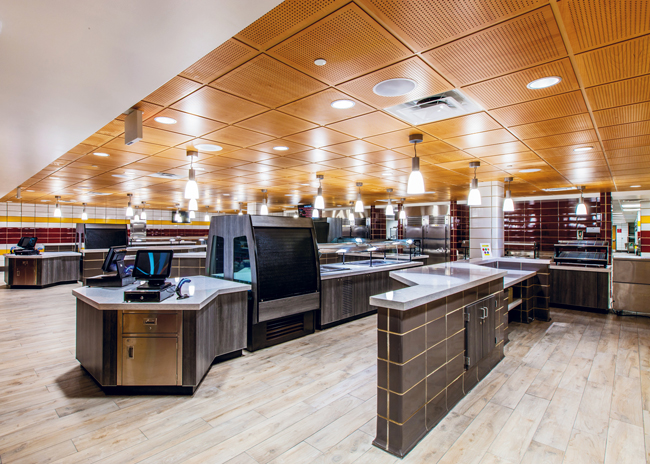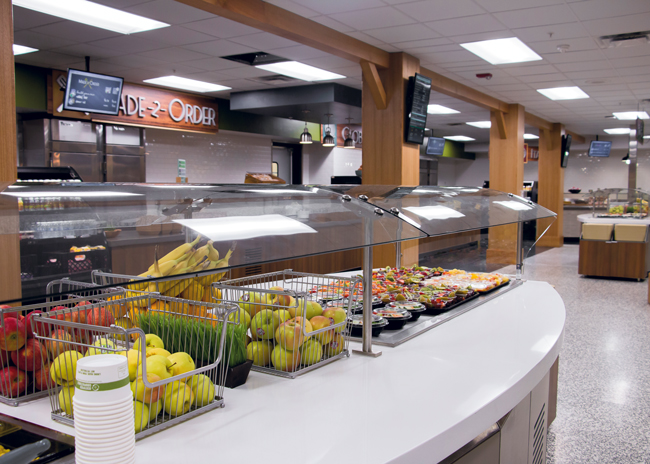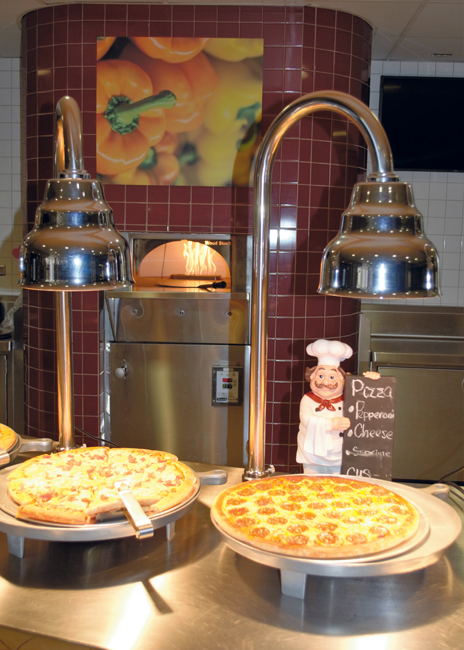School servery design does not typically adhere to a one-size-fits-all approach. What works best for elementary students is not necessarily a fit for middle or high schoolers. And with differing foodservice space allocations, budgets and program specifications, K-12 servery formats can take on seemingly endless variations.
“You can’t lump all K-12 serveries together,” says Scott Reitano, principal at Indianapolis-based Reitano Design Group. “The overarching piece across the board is where does control of the tray go: to the child or staff?”
With the elementary school set, handing control to staff expedites service and enables kids to move through the food line more quickly. In contrast, middle and high schoolers prefer to have more control in making their food choices with either a self-serve format or, in the case of a pandemic, a staffed servery.
“Anything that is not functional in the space is an opportunity to slow down speed of service,” says chef Michael Morris, senior manager, culinary offer implementation, for Sodexo, based in Gaithersburg, Md. “Students now get less than 20 minutes for lunch, so you have to serve quickly and function efficiently within the space.”
 The servery at Schaumburg High School, in Illinois, has multiple cashier stations to minimize long checkout lines.
The servery at Schaumburg High School, in Illinois, has multiple cashier stations to minimize long checkout lines.
Location & Placement
There are many variations with K-12 serveries, but designers agree a traditional speed line is most efficient in moving students through as quickly as possible. “The process becomes more cumbersome when kids are given more choices without a line format,” explains Cory Moe, senior designer at TriMark West in Irvine, Calif. “This results in loitering and more socialization when it’s all about keeping things moving.”
While elementary schools are more apt to utilize a central kitchen that services multiple schools with batch production, in middle school the transition is to more a la carte items. It’s high school where scramble serveries become more prevalent.
“In K-6, kids are governed by a meal program, so they don’t have many choices, and offerings change every day,” says Moe. “In that case, a functional design is about having everything close by and meeting health guidelines. Straight serving lines with cashiers on the front or back end, the ability to reheat meals from the school’s on-site kitchen and getting kids in and out quickly is the goal.”
In middle school, concession windows often become part of the mix for beverages and meal add-ons. “Here, it’s about having warming cabinets, refrigerated grab-and-go cases and dry goods available to pick up as quickly as possible,” Moe says.
At the high school level, foodservice becomes more challenging, as the criteria differs and depends on the district. “Items are mainly prepared on-site in high school kitchens, and there are grab-and-go coolers and walkup windows for items not on the meal program,” Moe says. “Some high schools have scramble serveries where students can go to the salad bar, grill station, pizza area, etc.”
No matter what the servery format, presentation matters. At the high school level, it’s more apt to have a collegiate aesthetic with open spaces amidst multiple food stations. “The decision is how lineal or open do you want to be, keeping in mind that the pinch point of speed becomes the point-of-sale area,” Reitano says. “By having more space between the POS and the last place food is served, backups are reduced and speed of service is enhanced.”
Like commercial foodservice, schools continue to contend with staffing challenges and need to adapt. Consider how serving line placement can help control lines, Morris advises. “There are challenges when serving lines can’t be modified to a full-serve model,” he says. “Consequently, we see a lot of crowd control measures put in place. This isn’t always best for a successful design since it also limits menu versatility [by curtailing serving space and, therefore, food offerings].”
For this reason, Sodexo prefers to have multiple serving lines within a wide-open space, rather than implement a more static serving line approach. This not only allows students to more easily access numerous areas, but also to interact with each other.
Private K-12 schools tend to have more servery food stations than public schools, according to Paul Kowalczyk, managing director/president of Lexington Independents, a culinary management company in Canonsburg, Pa, which provides dining services to K-12 private schools. “These schools want a dining service that emulates colleges and universities,” he says. “We want to ensure that the menu and speed of service fit the class schedules, as there will be different grades coming to eat at various times.”
 The grab-and-go station at Indiana’s Pendleton Heights High School features decorative baskets for fresh fruit.
The grab-and-go station at Indiana’s Pendleton Heights High School features decorative baskets for fresh fruit.
Rules of Thumb
While school foodservice tends to be slower to adapt to new equipment trends, the advancements do follow the same trendlines as commercial operations, with speed of service and flexibility in cooking techniques being two areas of interest for operators. “Many are transitioning to high speed or more versatile equipment,” Moe says. “Combi ovens are standard, along with braising pans that cook more efficiently in bulk.”
K-12 operators also use induction cooktops, but more to enhance service instead of as a display cooking function commonly used in commercial foodservice, Morris explains. “Built-in induction cooktops at the end of a serving line may not cook to order [due to time constraints and high volume] but can enhance batch-cooked food with fresh items as kids walk through,” he says. “A lot of what we do involves serving wells, and although we traditionally default to full-size hotel pans due to volume, there are opportunities [where we will incorporate] better pots and pans to display food.”
Marcin Zmiejko, associate principal at Denver-based YoungCaruso, adds that rather than an institution that serves the same menu, “some schools have introduced a la carte items with different equipment involved.”
That idea extends to display merchandisers. Beverages might be offered in open-air merchandisers rather than traditional milk coolers today, Zmiejko points out. “These look nice, are versatile and puts to use something already in the system but modifies it to fit into K-12 designs,” he says.
 This pizza station at Keller Independent School District, a K-12 school in Keller, Texas, features display cooking in a wood-fired pizza oven, with pies displayed under heat lamps.Because ergonomics and accessibility impact both staff and an operation’s ability to serve students of varying ages and heights, specifiers consider how tall the equipment is when specifying self-serve units. “A single servery may be used by 7-year-olds and 18-year-olds, so a design that allows for height differences across all age groups is critical,” Morris adds.
This pizza station at Keller Independent School District, a K-12 school in Keller, Texas, features display cooking in a wood-fired pizza oven, with pies displayed under heat lamps.Because ergonomics and accessibility impact both staff and an operation’s ability to serve students of varying ages and heights, specifiers consider how tall the equipment is when specifying self-serve units. “A single servery may be used by 7-year-olds and 18-year-olds, so a design that allows for height differences across all age groups is critical,” Morris adds.
Counter height represents another consideration. “Ergonomically for staff, these are typically 34 inches high, but for children it needs to be 32 inches for easy access,” Reitano says.
The number and placement of pass-through equipment from the kitchen to the servery represents another aspect foodservice designers must consider. “There is such a thing as having too many pass-throughs,” says Reitano.
Morris echoes that thought. “We’ve seen instances where there is no transition from the serving line to the convection oven right behind it, which creates a very loud environment when equipment is in operation,” Morris says. “We recommend a wall of pass-through equipment or a barrier between the kitchen and serving line.”
Volume dictates many decisions in K-12 foodservice design for Reitano, including the number of serving lines. “[With school foodservice,] it’s similar to a church bus showing up at McDonald’s, with three surges in a row,” he says. “A common mistake is not understanding how the school lunch program operates, which reveals how many serving lines are needed.”
In terms of functionality, Moe works to group areas together to decrease the number of steps staff must take. “Warming cabinets and refrigeration should be within a step or two to reload or serve.”
Zmiejko recommends thinking about foodservice programs in large school districts like a restaurant chain, which creates a more organized operation. “You want it designed [in a logical manner],” he says. “For example, when you open the door to the back kitchen, you want storage accessible right away for deliveries.”
A final misconception is thinking that a servery design from one school can be exactly replicated in another. “Even if we design kitchens for a foodservice director on a regular basis, we may not want to duplicate it every time,” Zmiejko says. “It’s not cookie-cutter — we can’t keep replicating the same designs. The segment and operator preferences are constantly changing.”



